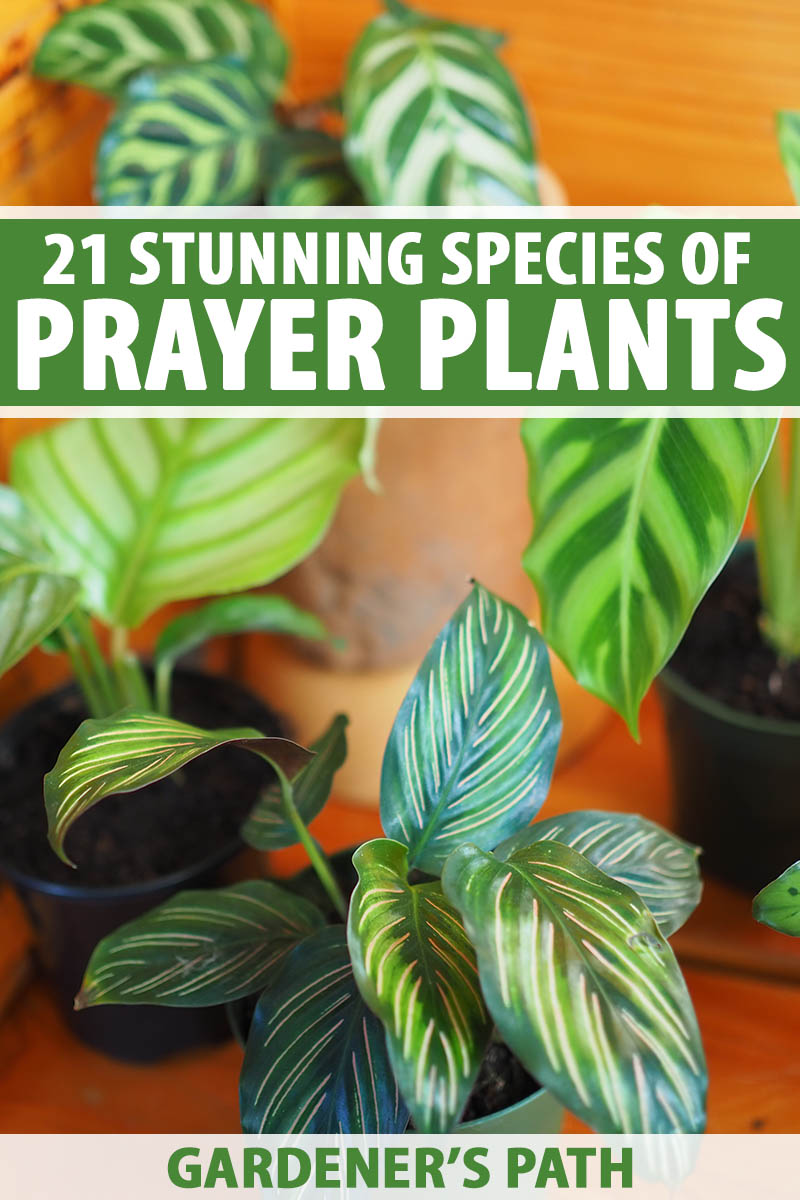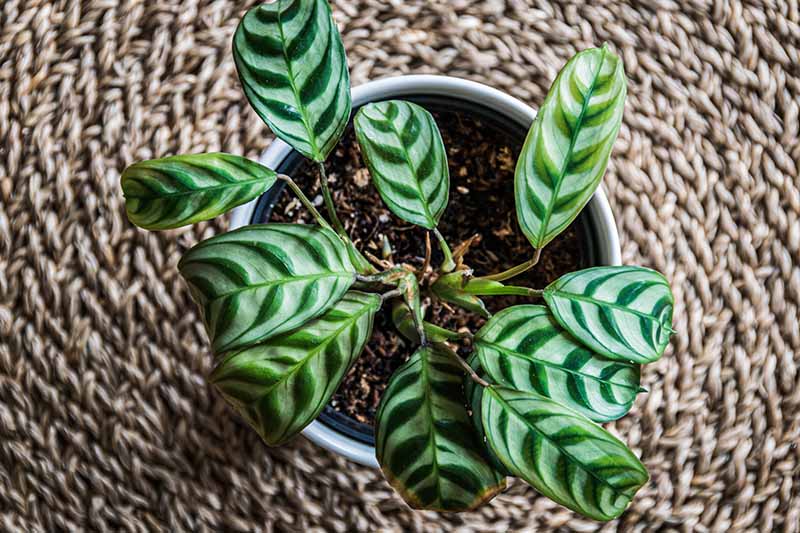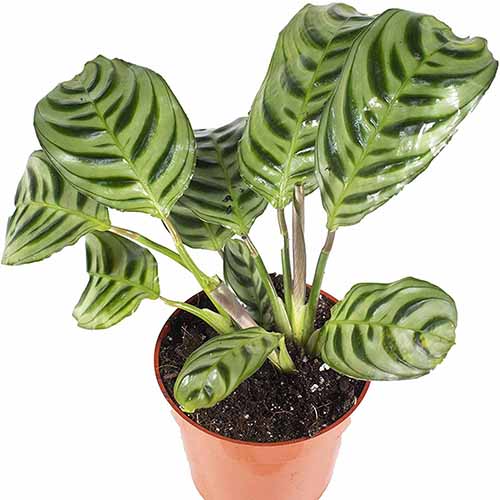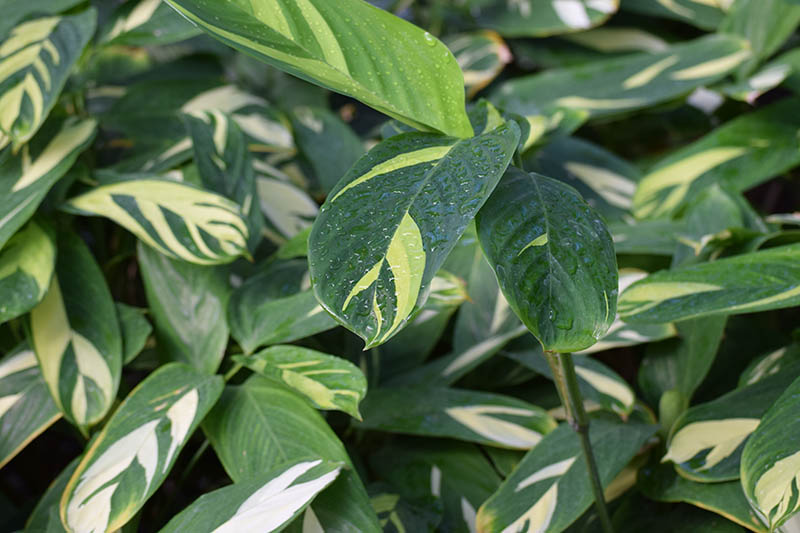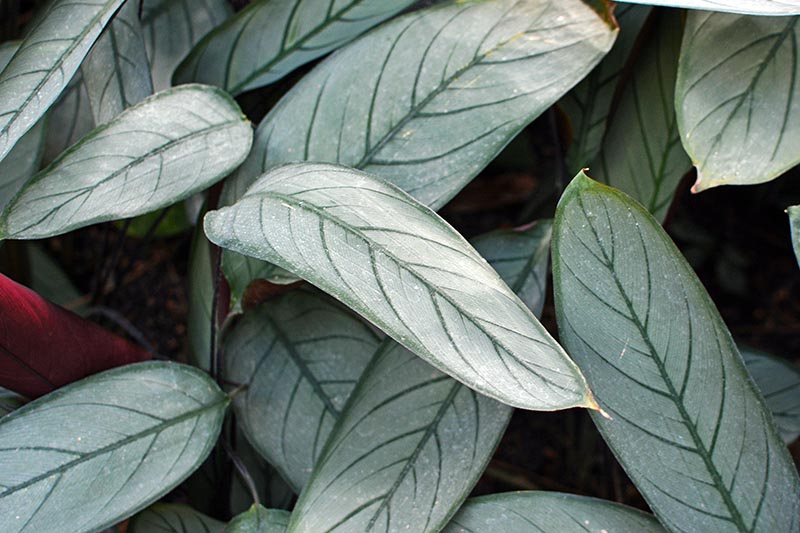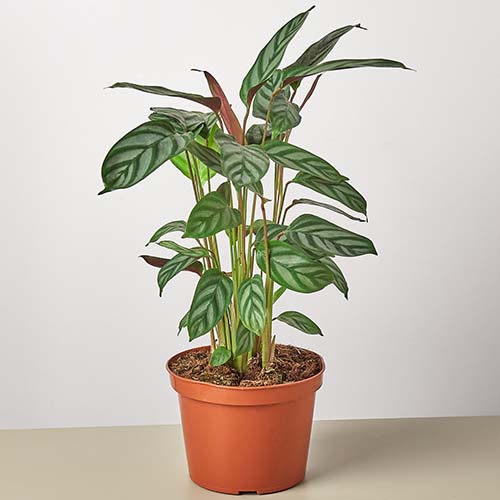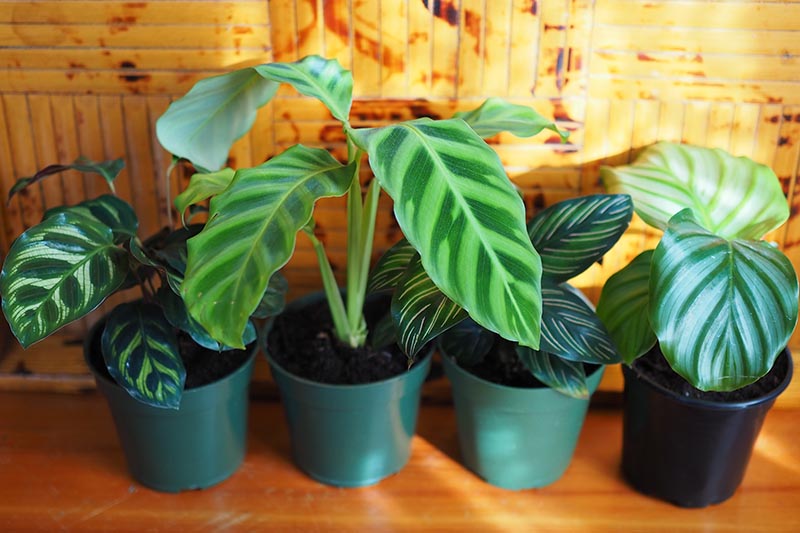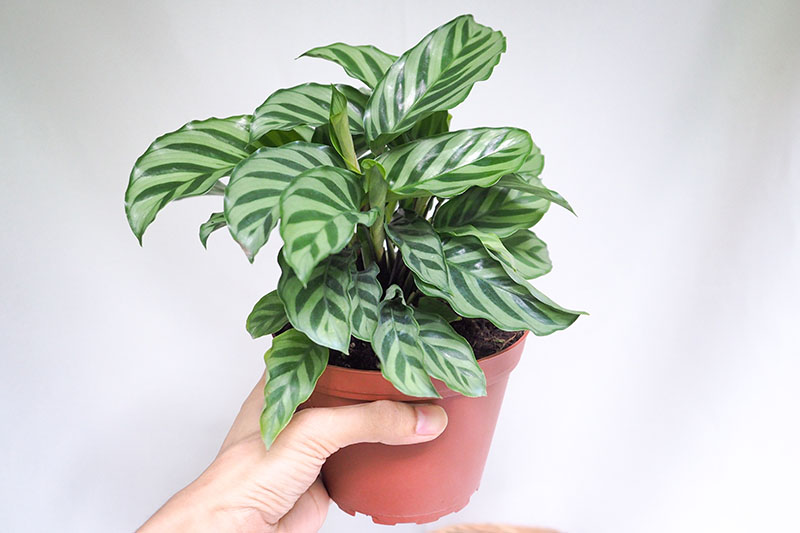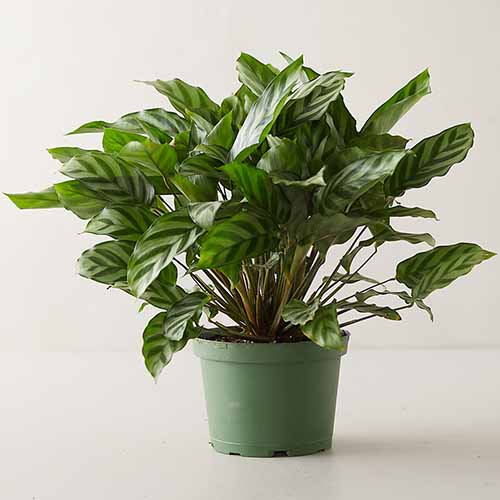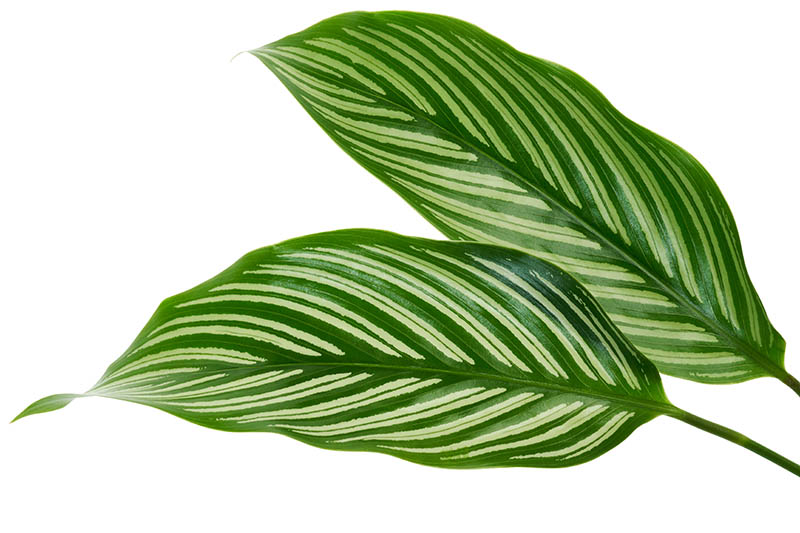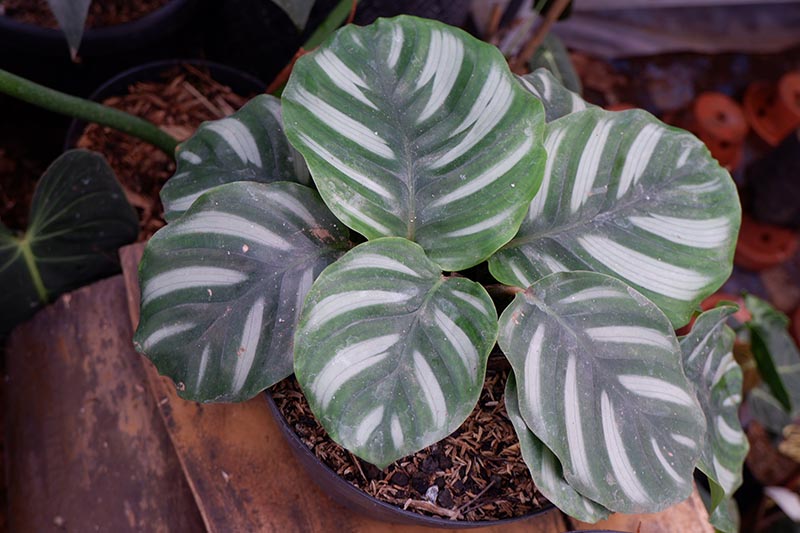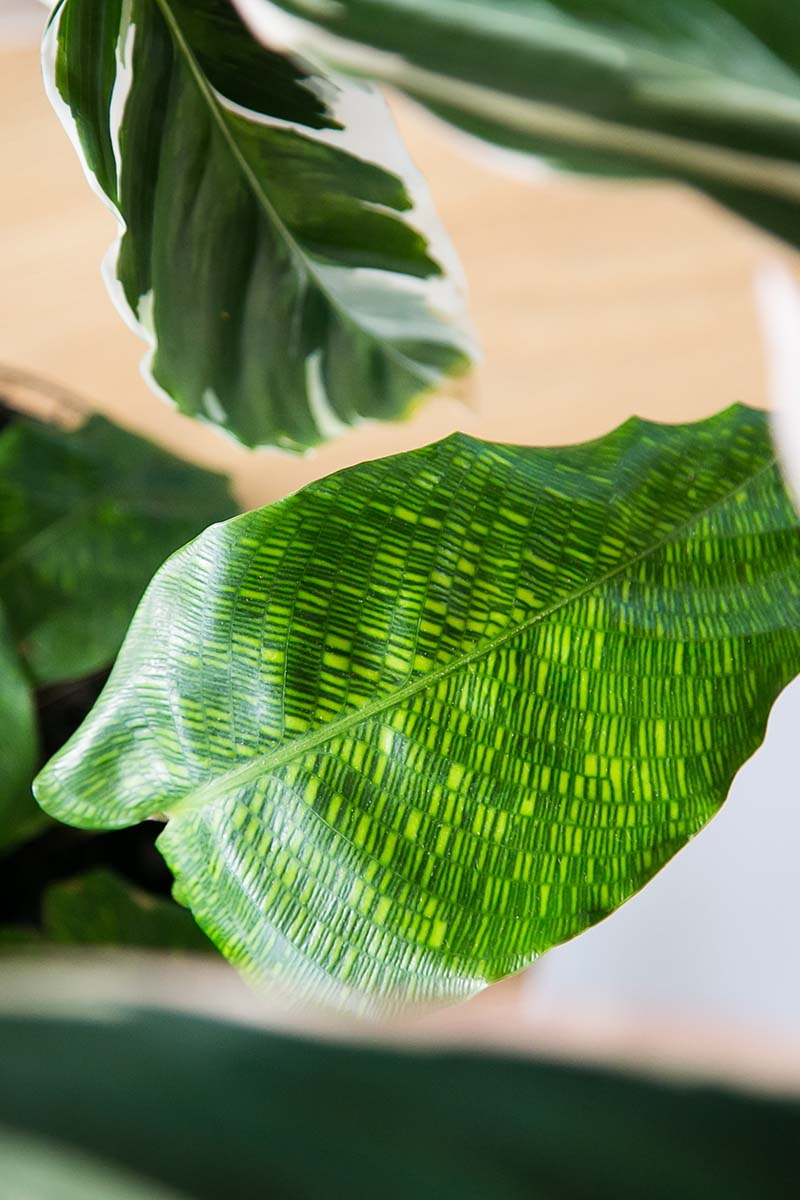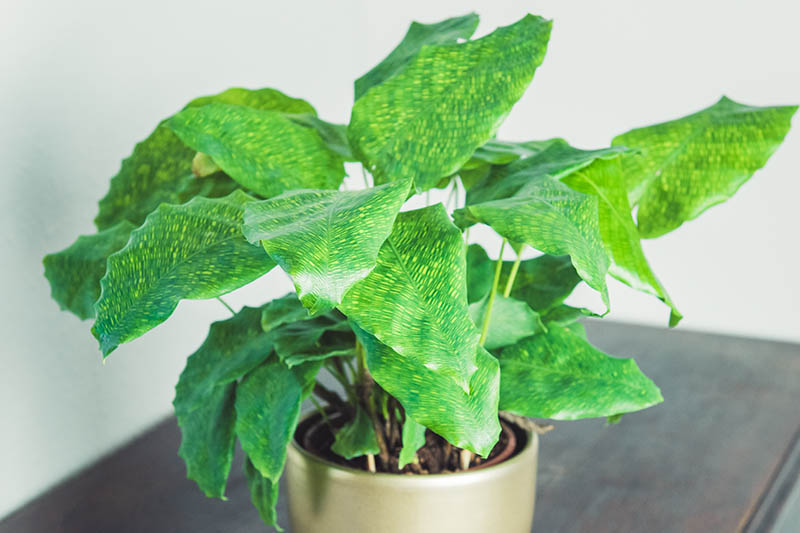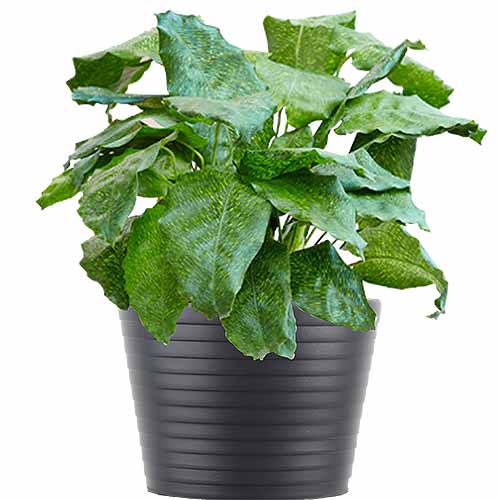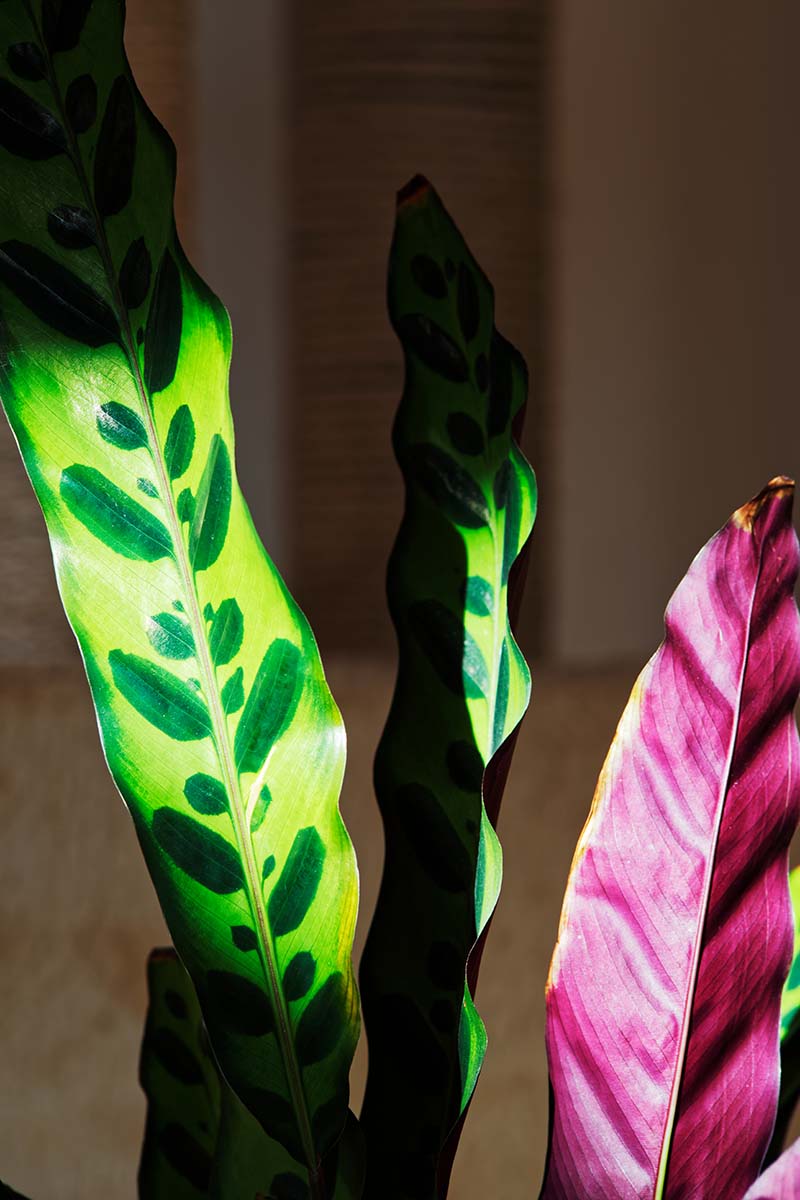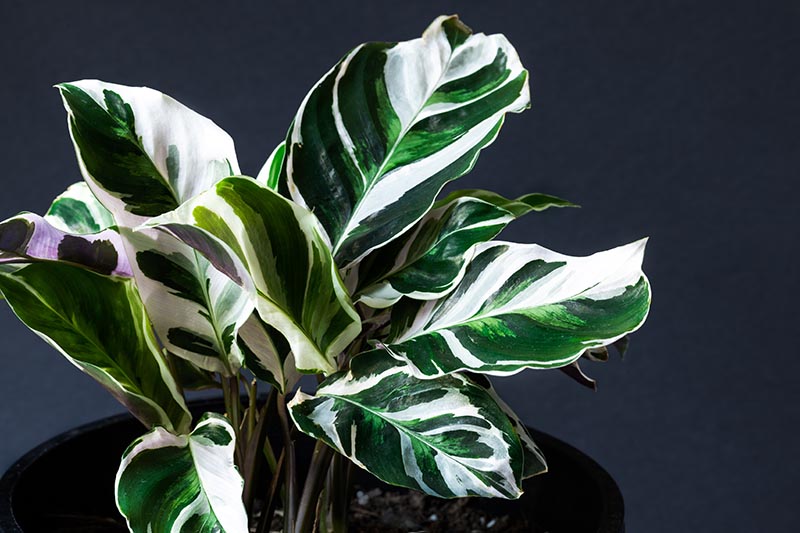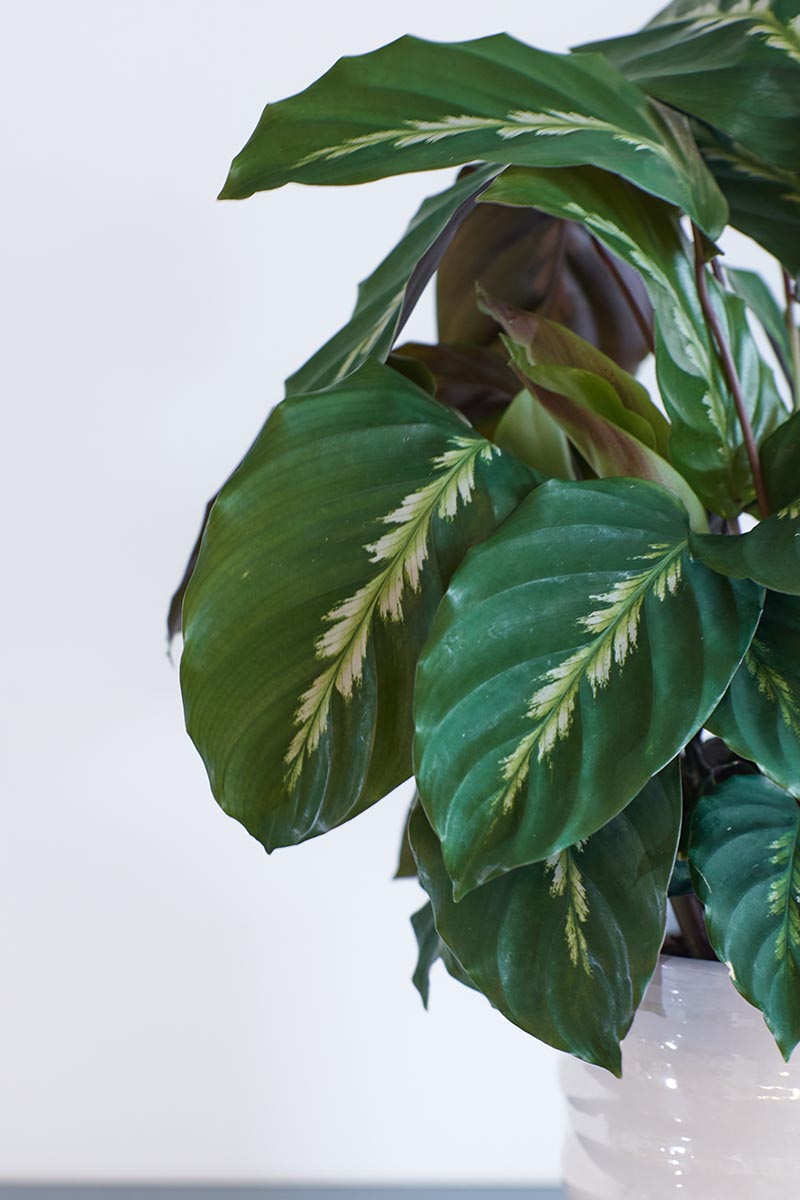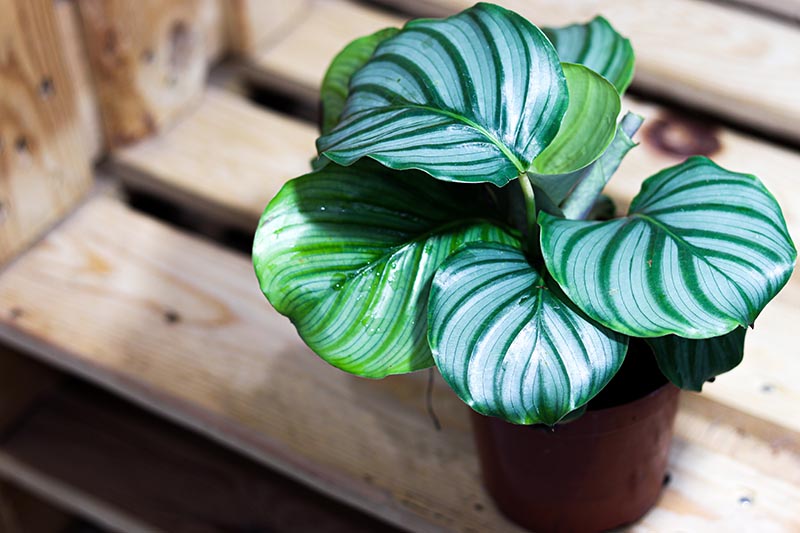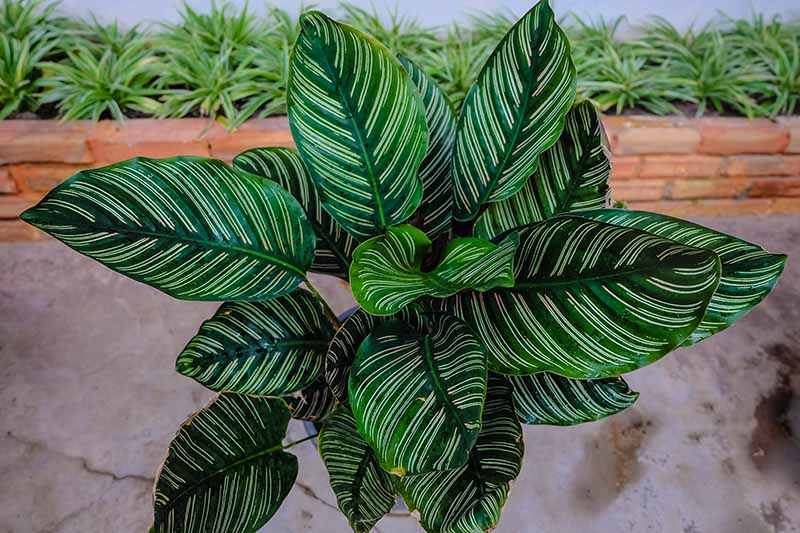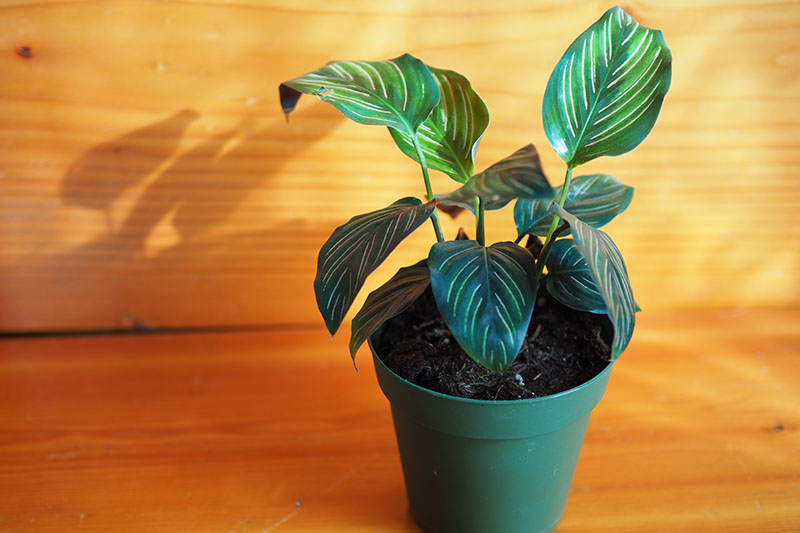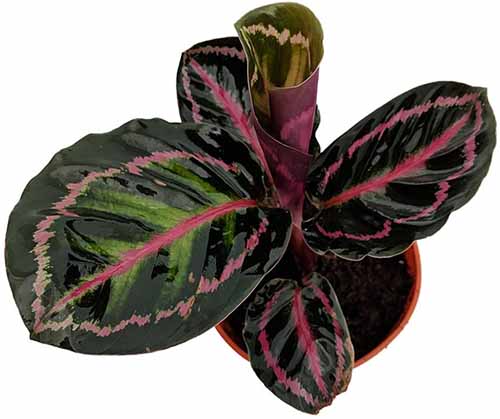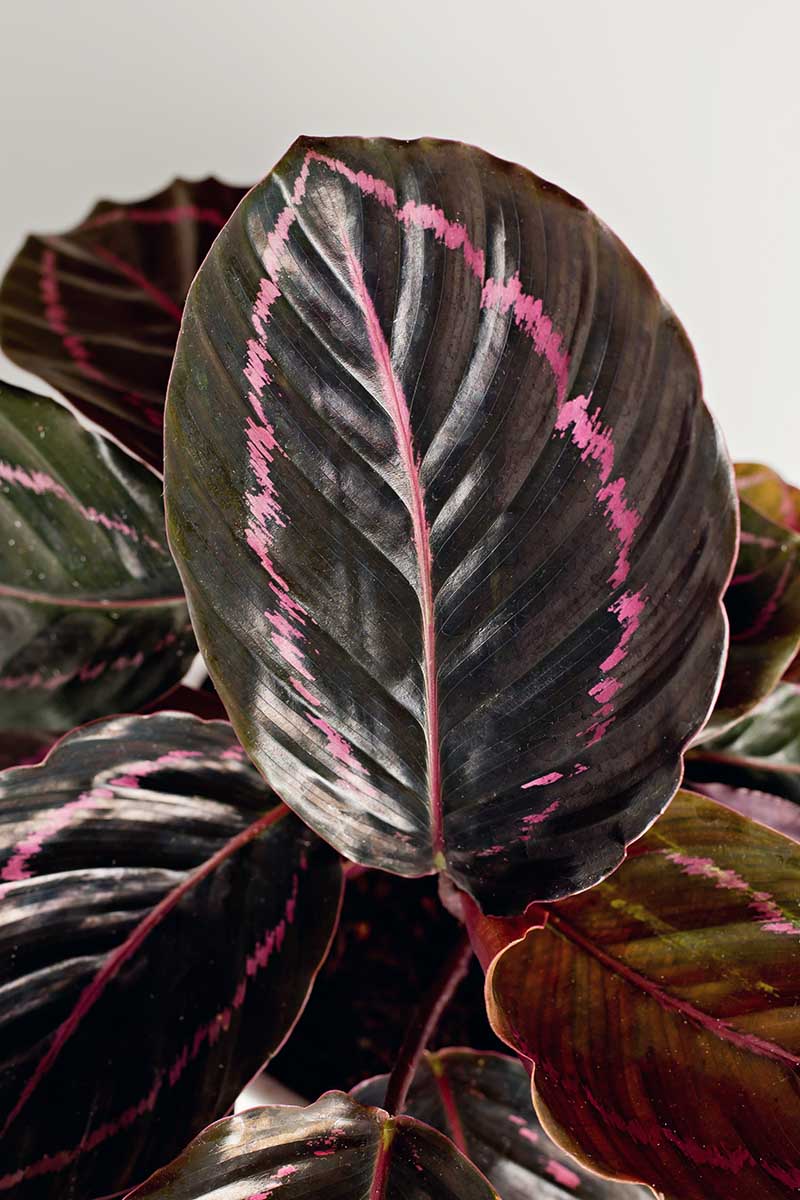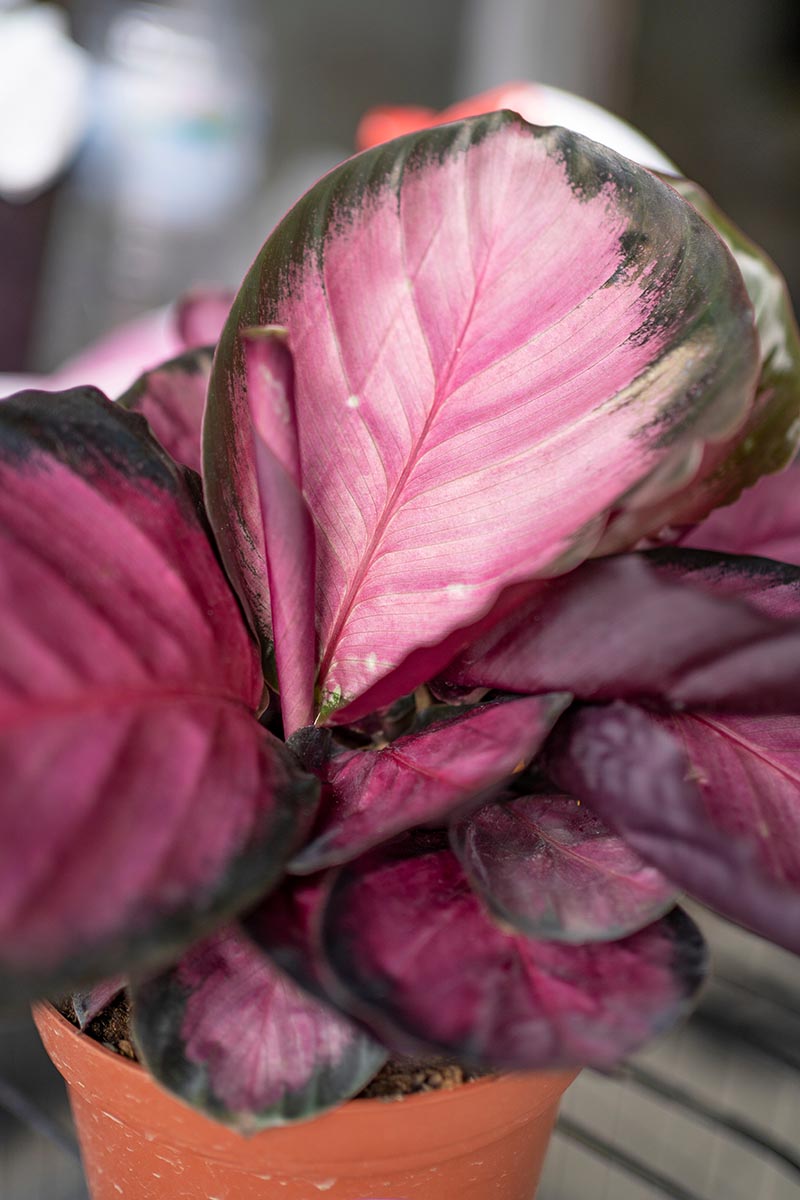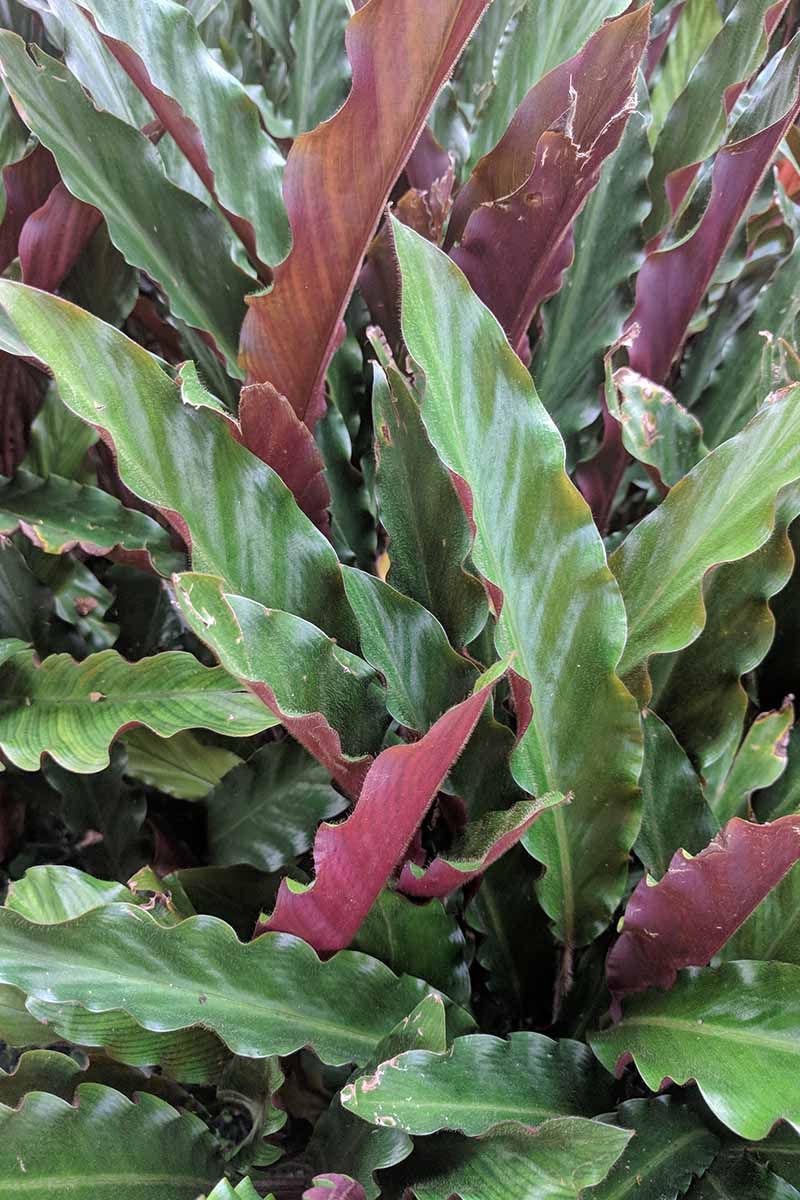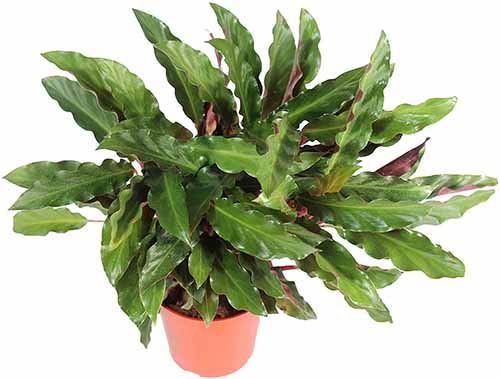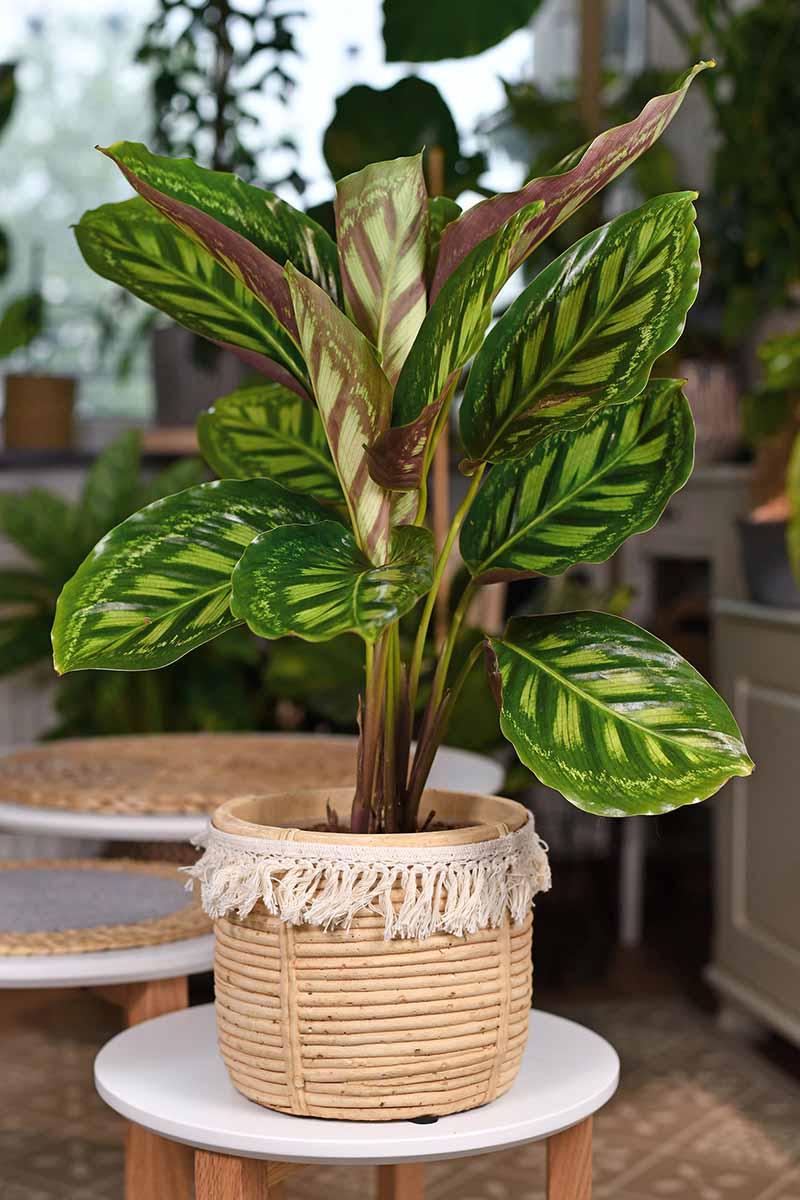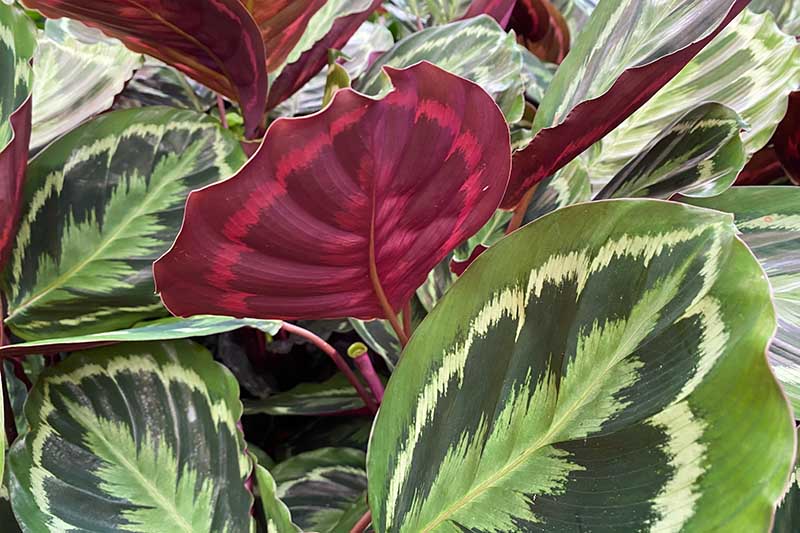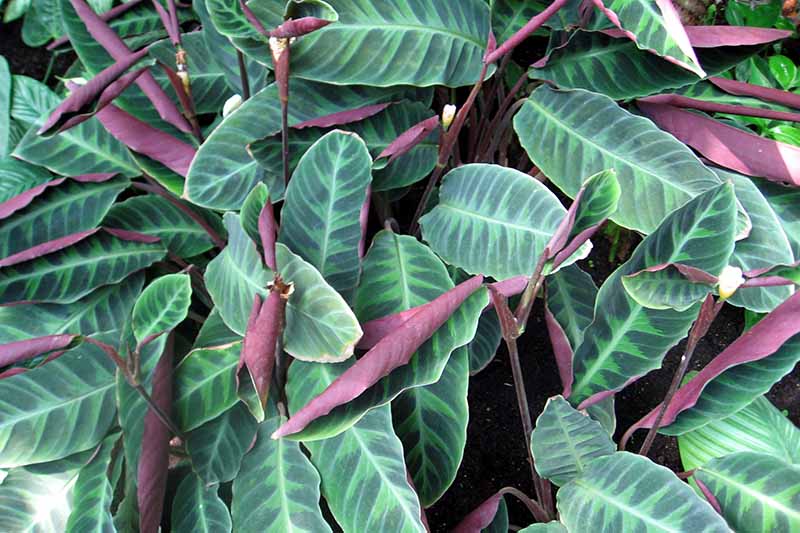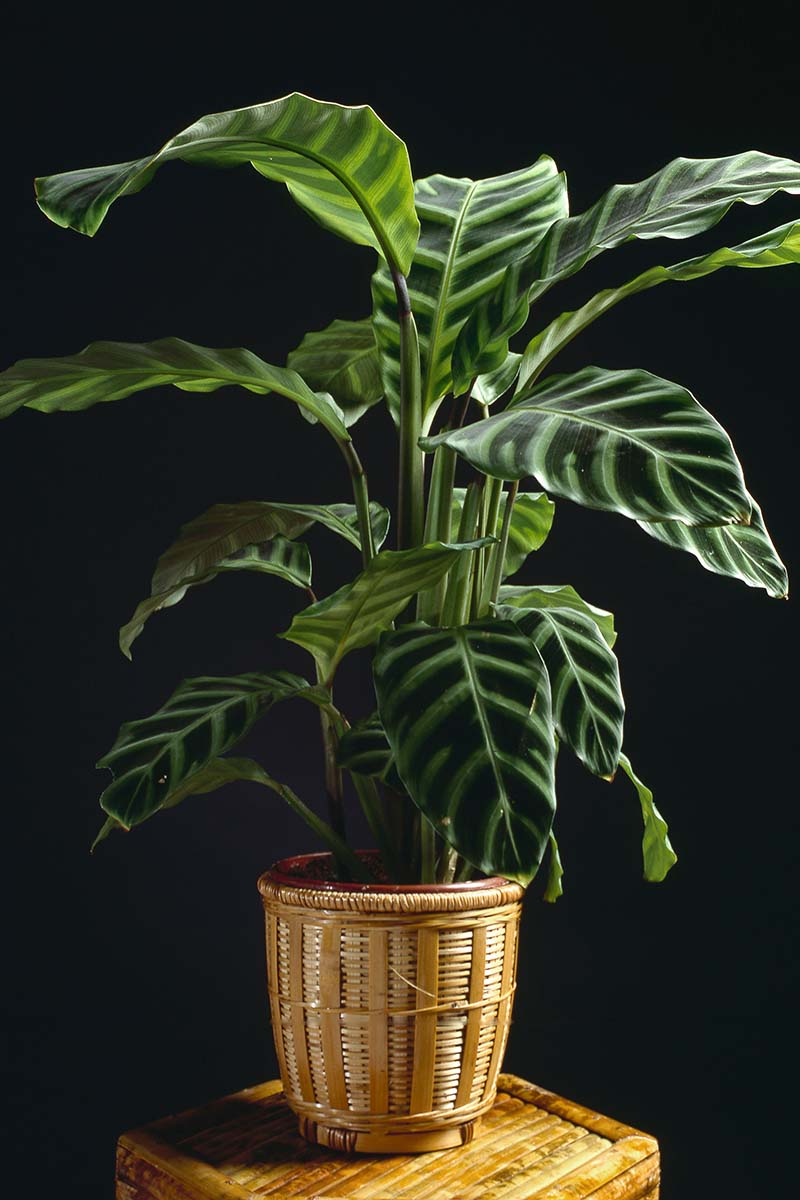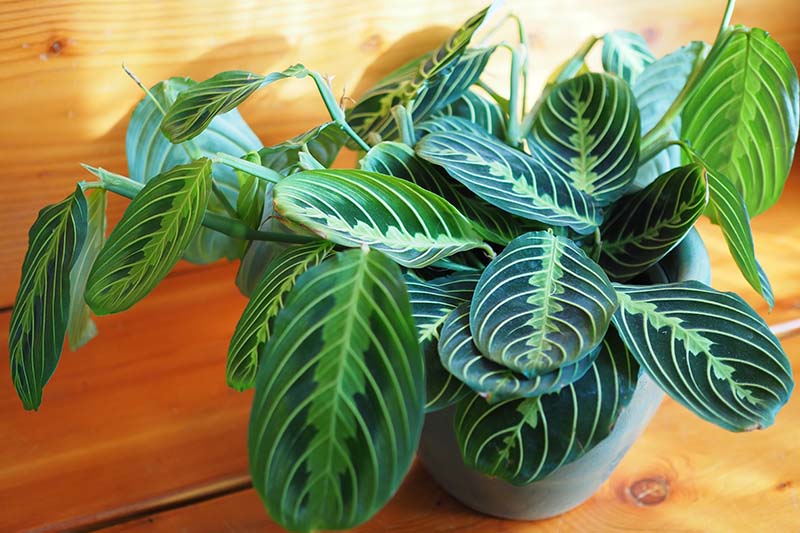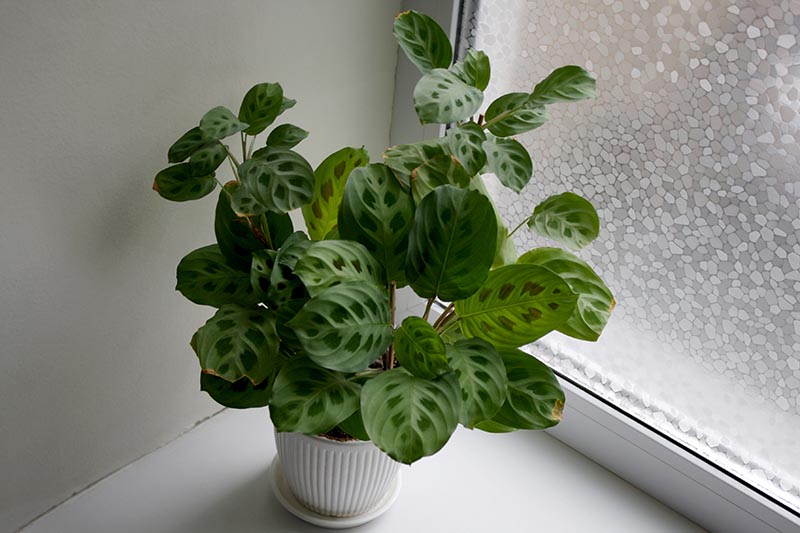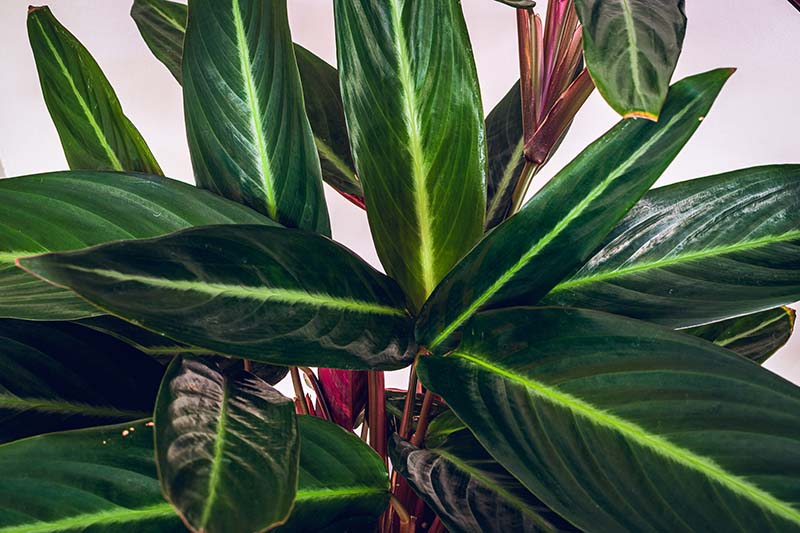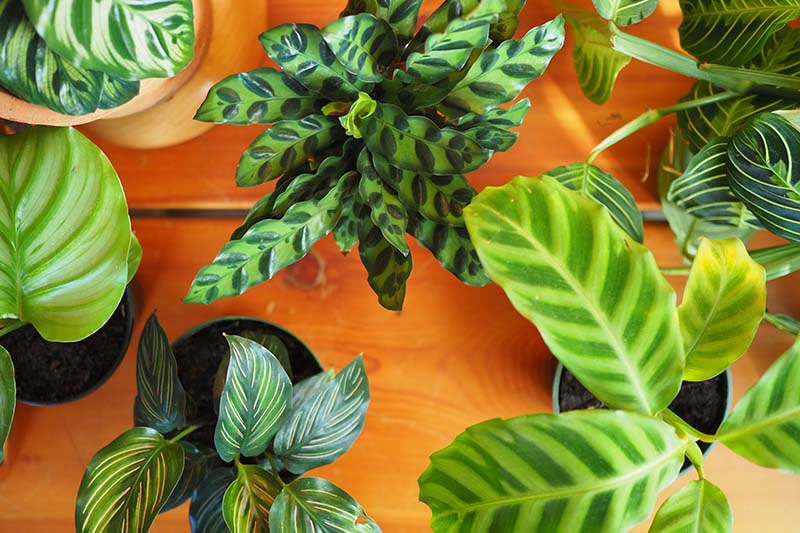But these houseplants are also cherished for the appearance of their stunning foliage. And thanks to the many different species and varieties available, there are a wide array of foliage patterns and color combinations to choose from. I made a list of some of the most gorgeous prayer plants out there, and then narrowed down my selection to 21 species and select cultivars that are also fairly easy to find as houseplants. We link to vendors to help you find relevant products. If you buy from one of our links, we may earn a commission. On our prayer plant tour, we’ll cover species plants as well as cultivated varieties. We’re going to meet some charming specimens, including calatheas (now considered goeppertias in terms of taxonomic classification), marantas, stromanthes, and ctenanthes. Based on my research, most (if not all) of these species and cultivars raise their leaves at bedtime. If you don’t already have a favorite type of prayer plant, I’ll bet you find one (or more) among this list that will turn your eye – and maybe even rivet your heart. Just a note before we get started, to reiterate what I briefly mentioned above: if you’re looking for calatheas and are disappointed not to see them in the table of contents, rest assured, they’re here. These members of the arrowroot family have been reclassified as belonging to the Goeppertia genus – you’ll find them under their new genus name below.
Ctenanthe
Ctenanthe – pronounced “te-NANTH-ee” – is one of thirty or so genera in the prayer plant family, Marantaceae. Ctenanthes are primarily native to Brazil, but also grow in Costa Rica, Panama, Colombia, Ecuador, Peru, Bolivia, and Venezuela. Like the other selections in this list, they raise their leaves at night and lower them again in the morning when the sun comes out. Here are some of the gorgeous Ctenanthe species you can keep as houseplants:
1. Burle Marxii
This species, native to Brazil, was named in tribute to a landscape architect – also from Brazil – by the name of Roberto Burle Marx. Ctenanthe burle marxii has paddle-shaped leaves that are either bright green or pale silvery gray, with a darker green fishbone pattern, which gives this species its common name, “fishbone prayer plant.” The undersides of its leaves are a lovely maroon color, and are visible as new leaves unfurl as well as when its foliage raises at night. C. burle marxii was previously classified as a Maranta – a genus we’ll be visiting a bit later in the article – and is sometimes still referred to as Maranta amabilis. While flowers are rarely produced when this species is kept as a houseplant. When they do appear, they are small, inconspicuous, and white in color. Fishbone prayer plant has a wider spread than height, making it a good choice for a hanging basket. It reaches eight to 12 inches high and has a spread of 18 to 24 inches. Live Fishbone Prayer Plant in 4” Pot ‘Amagris’ is a cultivated variety of C. burle marxii, which you might be able to find to add to your collection at home. ‘Amagris’ has paddle shaped leaves that are silver with thin, medium green leaf veins and midribs, and purple undersides. The otherwise rounded leaves have a distinct, spike-like leaf point. Like the species plant, flowers of ‘Amagris’ are small and white, but appear rarely on houseplants. This cultivar is also called ‘Marantha Amagris,’ and can grow up to 16 inches tall and wide at full maturity.
2. Lubbersiana
Unlike the highly symmetrical patterns you will find on most prayer plants, Ctenanthe lubbersiana has marbled yellow and cream variegation on its medium green foliage. Leaves are oblong and rounded. This Brazilian native – previously classified as Stromanthe lubbersiana – goes by the common name “bamburanta,” and is also sometimes called “never never plant.” One of the larger species among prayer plants, bamburanta can grow to be two to four feet tall and two to three feet wide. When flowers appear, they are tiny and white in color. Bamburanta won the Royal Horticultural Society’s Award of Garden Merit for ornamentals in 1993. Ctenanthe Lubbersiana Bamburanta Live Plant in 6” Pot
3. Setosa
‘Grey Star’ is a cultivated variety of Ctetanthe setosa that you’re sure to enjoy. This variety has long elliptical leaves that come to a point, with a pale silver hue, darker leaf veins, and reddish-purple undersides. The understated flowers of this variety are tiny and white when they appear. On the larger size as far as prayer plants go, ‘Grey Star’ can reach up to five feet tall and up to three feet wide.
‘Grey Star’ Live Plant in 6” Pot You’ll find ‘Grey Star’ plants available for purchase in six-inch pots from the House Plant Shop, via Walmart.
Goeppertia
Next, I’d like to introduce you to the Goeppertia genus, pronounced “go-PER-shuh.” All of the species in this section were previously classified as belonging to the Calathea genus, but have been reclassified. What’s the reason for this change? A DNA analysis carried out in 2012 revealed some genetic differences in these species when they were compared to other calatheas. The researchers involved in this analysis determined that these species deserved a genus of their own. So the bulk of the species in the Calathea genus were then reclassified as Goeppertia. I’m calling this, informally, “the great calathea reclassification of 2012.” However, houseplants belonging to this genus are still commonly referred to as “calatheas” by vendors, buyers, and gardeners – so when you’re hunting for one to buy, searching for calatheas may come in handy. The species in this genus originated in Mexico, Central America, the Caribbean, and South America.
4. Concinna
‘Freddie,’ a cultivated variety of Goeppertia concinna, has ovate, pointed leaves that are a pale, silvery green with a dark green herringbone pattern. ‘Freddie’ has an upright growth habit and will grow to be up to 20 inches tall with a 20-inch spread.
G. concinna ‘Freddie’ Live Plant If ‘Freddie’ looks like the vegetative buddy for you, you can find him waiting patiently at Terrain.
5. Crocata
Goeppertia crocata has large, dark green leaves with purple undersides. The foliage has a wavy texture. The specific epithet crocata means “saffron colored,” and refers to the bright, golden orange flowers of this species from Brazil. It can be found under the synonymous scientific name Calathea crocata as well as one of its common names, “saffron-colored calathea.” Its other common name, “eternal flame plant,” is also inspired by the species’ showy blooms, which are one to two inches in size. G. crocata has an upright growth habit and can grow to be 18 inches tall with a spread of up to 12 inches. This brightly flowered species will thrive in soil that is slightly acidic to slightly alkaline.
6. Elliptica
Goeppertia elliptica has long, pointed, oval-shaped leaves that are a medium green color graced with thin white stripes. The undersides of the foliage are light green. Also known as G. vittata, this species was formerly classified as Calathea elliptica or C. vittata, and is native to northern South America.
With an upright growth habit, G. elliptica grows to be eight to 12 inches in height and has a spread of six to eight inches. Flowers, when they appear, are cream colored. G. elliptica Live Plant in 4” Pot
7. Fasciata
Goeppertia fasciata has large, rounded leaves that have broad, dark green stripes and midribs, with contrasting light green to gray stripes. The undersides of its leaves are dark red to purple. This species, native to northeast Brazil, was formerly classified as Calathea fasciata but is also sometimes referred to as Maranta borussica. G. fasciata has inconspicuous white flowers that usually only appear when grown outdoors. This species can grow three to four feet in height with a spread of one and a half to two feet. When repotting, take note that G. fasciata prefers soil that is strongly to moderately acidic.
8. Kegeljanii
‘Network’ is a cultivated variety of Goeppertia kegeljanii that I’m confident you’ll want to add to your houseplant collection. It has a surprising pattern on its foliage – a fine green and yellow mosaic. The pattern is fairly subtle, being more noticeable when viewed from close up. Native to Brazil, this species has gone by many different names, reflecting its previous classifications. When classified as a Calathea it was known as C. bella, C. musaica, and also C. cardiophylla. Categorized as a Maranta, it was called M. kegeljanii, M. tessellate var. kegeljanii and M. bella. And another one of its synonyms and previous monikers is Phyllodes bella. Putting this matrix of names aside, when searching for a specimen to purchase, you will be the most likely to find what you’re looking for if you search for “Network calathea.” The leaves of ‘Network’ are oval and pointed with slightly wavy margins, giving them something of an oversized holly leaf appearance. The cultivar, patented in 2008 and officially given the not-very-exhilarating name ‘PP0005,’ has more prominent variegation and a bushier shape than the species plant. ‘Network’ has an upright habit, growing to be eighteen to twenty-four inches tall and twelve to eighteen inches wide.
G. kegeljanii ‘Network’ Live Plant in 6” Pot If you’d like to bring this living mosaic into your living space, you’ll find ‘Network’ from Costa Farms in a six-inch pot, available via Walmart.
9. Insignis
Native to Brazil, Goeppertia insignis has long, narrow, pointed leaves and a pattern that gives it its common names, “rattlesnake plant” or “rattlesnake calathea.” Its foliage is light green to yellowish green with alternating large and small dark green blotches. Rattlesnake calathea is also known botanically as G. lancifolia, Calathea lancifolia, and C. insignis.
The leaves of this species are extremely wavy, and their undersides are purple or maroon in color. Rattlesnake calatheas have a fountain-like spreading growth habit, and can grow to be twenty to thirty inches tall and wide.
Live Rattlesnake Calathea in 6” Pot To add this beautiful specimen to your prayer plant collection, you’ll find rattlesnake calathea for purchase from Hirt’s Gardens in a six-inch pot via Walmart. Learn more about growing rattlesnake plants in our dedicated growing guide.
10. Lietzei
While most of the specimens included in this roundup have very symmetrical patterns on their foliage, ‘Fusion White’ is quite different, and looks as though it could have been painted by the hand of an impressionist. Each oval-shaped leaf has a unique marbled pattern of white with multiple shades of green variegation, and lilac-hued undersides. ‘Fusion White’ is a patented cultivar, and like the other Goeppertias in this list, ‘Fusion White’ has been reclassified. Nonetheless, it is still commonly called Calathea lietzei ‘Fusion White,’ or simply ‘Fusion White’ calathea. ‘Fusion White’ Live Plant in 4” Pot Also known as ‘White Fusion,’ this cultivated variety has a semi-upright, compact growth habit and grows to be six to eight inches tall with an eight to 12-inch spread.
11. Louisae
‘Maui Queen’ is a cultivated variety of Goeppertia louisae, a species also known by the synonym Calathea louisae. This cultivar’s pointed, oval-shaped green leaves feature a creamy feathered pattern along the midrib, and have purple undersides. ‘Maui Queen’ has an upright growth habit, and will reach 18 to 24 inches in height with a spread of twelve to 18 inches. Make sure to keep ‘Maui Queen’ in neutral to slightly acidic potting soil.
12. Makoyana
Goeppertia makoyana is a species from eastern Brazil that is also called “peacock plant.” It seems that somebody, somewhere found its foliage looked like the flashy feathers of a peacock, and the name stuck. This species has glossy, oval-shaped leaves that look like they were designed by an artisan – the tops are creamy with medium green leaf margins, and darker green splotches radiating from the midvein. Its other common name – which I personally find much more convincing – is “cathedral windows.” This vivid moniker is inspired by the leaves’ semi-translucent appearance: when viewing the undersides of the foliage, light shines through the leaves, revealing the same pattern on the leaf bottoms, but in purple instead of green. Before the great calathea reclassification of 2012, this species was known as C. makoyana, and is often still described as such by vendors. Cathedral windows exhibits a habit that is more upright than spreading, and can grow up to two feet tall and about one foot wide. In 1993, this species won the Royal Horticultural Society’s Award of Garden Merit in the ornamentals category. Cathedral Windows Live Plant in 6” Pot Learn about growing peacock plant in our dedicated growing guide.
13. Orbifolia
Goeppertia orbifolia has broad, round leaves that are boldly striped in silver and light to dark green, with pale green undersides. This stunning species, native to eastern Brazil, was formerly classified as Calathea orbifolia. One of the larger specimens in this list, G. orbifolia can grow to be three feet tall with a three-foot spread. This species performs well with slightly acidic to slightly alkaline soil.
Goeppertia orbifolia Live Plant You can purchase G. orbifolia for your at-home enjoyment from Terrain.
14. Ornata
Goeppertia ornata, or “pinstripe plant” as it’s also called, has dark green, elliptical, pointed leaves with thin, pinkish white stripes that look like they were hastily – but artistically – applied by the fine brush of a painter. Pinstripe plant is also known as Calathea ornata and G. ornata majestica. It is native to southeast Columbia and southwest Venezuela. Pinstripe plant has an upright growth habit. It can reach two to three feet tall with a two to three-foot spread. When repotting, bear in mind that G. ornata is tolerant of slightly acidic to slightly alkaline soil. Learn more about growing the pinstripe prayer plant in our growing guide. ‘Beauty Star’ is a cultivated variety of G. ornata that has pointed, elliptical leaves which are light green with darker margins, dark green centers, and thin creamy pink stripes “painted” on the leaves. Compared to the species plant, ‘Beauty Star’ is different in that it has patches of lighter green behind its creamy pink stripes. Because of the species’ reclassification, make sure to look for this specimen as ‘Beauty Star’ calathea if you’re struggling to locate it. With an upright habit, ‘Beauty Star’ can grow to be twelve to eighteen inches in height with an equal spread. Like the species, this cultivar can handle slightly acidic to slightly alkaline soil.
Live ‘Beauty Star’ Calathea in 4” Pot You’ll find ‘Beauty Star’ for purchase in a four-inch pot from Hirt’s Gardens via Walmart.
15. Roseopicta
The species name for G. roseopicta means “rose-painted” – but that description, as well as this tropical specimen’s common name, “rose-painted calathea,” don’t really do justice to everything that’s going on with the pattern on its foliage. As well as a feathery cream or pink outline on the oval-shaped leaf, there are wide, dark and light green stripes, a bright pink midrib, and wide emerald green margins. And as new leaves are produced, their purple undersides are displayed. This species is native to Brazil, Colombia, Ecuador, and Peru, and is also known as Calathea roseopicta and C. illustrus. G. roseopicta grows to be 12 to 18 inches tall and has a one-foot spread. This beautiful species won the Royal Horticultural Society’s Award of Garden Merit in 2002. Live G. Roseopicta Rose-Painted Prayer Plant in 4” Pot ‘Dottie’ is a cultivated variety of G. roseopicta that has dark green, oval leaves appearing almost black in color, with thin, feathery pink leaf outlines and pink midribs, and undersides that are red to dark purple. Since the species’ name has changed, this cultivar’s name has as well. It is still often called rose-painted calathea ‘Dottie,’ and Calathea roseopicta ‘Dottie.’ ‘Dottie’ will reach 12 to 18 inches in height with a 12 to 18-inch spread.
Goeppertia roseopicta ‘Dottie’ Live Plant You’ll find the black and pink colored ‘Dottie’ available for purchase at Terrain. Another cultivated variety of G. roseopicta, ‘Rosy’ has large, rounded leaves that have blackish green margins surrounding an interior that is silvery mauve to bright fuchsia in color, with pink undersides. This cultivar also goes by the names C. roseopicta ‘Rosy’ and rose-painted calathea ‘Rosy.’ This cultivated variety can grow to be one to two feet tall with a one to two-foot spread. ‘Rosy’ Live Plant in 6” Pot Ready to cheer up your home with a ‘Rosy’ plant?
16. Rufibarba
With long, feather shaped leaves, Goeppertia rufibarba is all about texture. G. rufibarba has extremely wavy, dark green leaves that are covered with tiny hairs, giving them a soft, fuzzy feel – thus this species’ two common names, “furry feather calathea” and “velvet calathea.” Because of the genus name change mentioned previously, this species, a native of northeast Brazil, is also referred to as Calathea rufibarba. This prayer plant has an upright growth habit, growing up to three feet tall and 18 to 20inches wide. Its flowers are a showy bright yellow. Furry feather calathea won the Royal Horticultural Society’s Award of Garden Merit in the ornamentals category in 2012. Furry Feather Calathea Live Plant in 4” Pot
17. Veitchiana
‘Flamestar,’ a cultivated variety of Goeppertia veitchiana, looks like it holds an entire jungle right in its foliage. This cultivar’s large, oval-shaped leaves display yellow highlights and several shades of green, within a feathery outline and wide green margins. On the underside of the leaves, the same pattern is imprinted, but with purple replacing the green. This cultivar is also known as Calathea veitchiana ‘Flamestar,’ or simply ‘Flamestar’ calathea. Among the entries on this list, this variety may prove to be harder to find. ‘Flamestar’ has an upright growth habit and can grow to be up to 24 inches tall. Another cultivated variety of G. veitchiana, ‘Medallion’ has large, rounded leaves with a feathery pattern. A pale green blaze lies along the midrib, surrounded by darker green, and then a creamy feather-shaped outline is enclosed in wide, pale green leaf margins. The undersides of the leaves are purple or maroon colored. This boldly patterned variety is often described and sold as rose-painted calathea or Calathea roseopicta, but it is in fact a different species than G. roseopicta, described above. There is a family resemblance, nonetheless, and it’s easy to understand why these two often get confused. However, ‘Medallion’ lacks the stripes of G. roseopicta, and the feathery part of its pattern is bolder and more distinctive.
‘Medallion’ Live Plant in 4” Pot This prayer plant will grow to be 12 to 24 inches tall with a similar spread. You’ll find ‘Medallion’ for purchase in a four-inch pot from Hirt’s Gardens via Walmart.
18. Warszewiczii
This gorgeous species, Goeppertia warszewiczii, is called by its common name “jungle velvet” because of its large, velvety leaves. Jungle velvet’s foliage has an ovoid shape, tapering to a point. The leaves are dark green with an emerald blaze along the midrib, and burgundy undersides. Previously classified as a calathea, this species – native to Central America – is still frequently called Calathea warszewiczii, C. warscewiczii (spelled with a “c”), or simply “jungle velvet calathea.” Unlike most members of the arrowroot family commonly grown as houseplants, when jungle velvet blooms, it has large, showy flowers. These flowers transition from cream to yellow and then pink in color.
Jungle velvet is one of the larger prayer plants and it grows upright, reaching up to 40 inches tall and 40 inches wide.
19. Zebrina
Goeppertia zebrina has large, elliptical shaped leaves that taper to a point, and are light green in color with wide, dark green stripes that are forked at the leaf margins. The underside of the foliage is green. Known as “zebra plant” because of its stripes, G. zebrina is native to Brazil. This species was formerly classified as Calathea zebrina and is still commonly referred to as “zebra calathea.” Zebra calathea has a fountain-like shape, growing to be two to three feet tall with a two to three-foot spread. This species won the Royal Horticultural Society’s Award of Garden Merit in the ornamentals category in 1993. Live Zebra Plant in 6” Pot Learn more about growing this stripey specimen in our dedicated article on growing zebra calathea.
Maranta
Marantas may be among the most commonly enjoyed prayer plants – though that certainly does not make them boring. The species in the genus Maranta – pronounced “ma-RAN-tah” – originate in Central and tropical South America. Like other prayer plants, marantas raise their leaves as the sun goes down in the evening, and lower them again when the sun rises in the morning.
20. Leuconeura
‘Lemon Lime’ is a cultivated variety of M. leuconeura, and is closely related to the red-veined prayer plant. ‘Lemon Lime’ has foliage in various shades of green, with a bold pattern. A pale green blaze on the midrib is surrounded by medium or dark green coloring on the leaves, and bright lime green veins. The leaf veins are raised on its foliage, giving ‘Lemon Lime’ textural interest as well. The undersides of the leaves on this variety are pale green. ‘Lemon Lime’ has oval-shaped leaves that are five to six inches long. This cultivar has a spreading growth habit and works wonderfully in hanging baskets. It will grow to be 12 to 15 inches tall and has a matching spread.This variety produces tiny purple flowers in the summertime.
‘Lemon Lime’ Live Plant If you’d like to add this cultivar to your houseplant collection, you’ll find one for purchase from Terrain. ‘Fascinator’ is another cultivar of M. leuconeura that you may enjoy, also known as “black prayer plant.” It has dark green to blackish leaves with a pale green midrib blaze, and brightly contrasting reddish-purple veins. Another excellent selection for a hanging basket, ‘Fascinator’ has a spreading growth habit, and can grow to be up to 15 inches wide and 15 inches tall. Also belonging to this species, M. leuconeura var. kerchoveana is a naturally occurring variety that’s closely related to ‘Lemon Lime’ and ‘Fascinator.’ This type, sometimes referred to as the “green prayer plant,” is also called “rabbit’s foot” and “rabbit tracks,” in reference to the patterns of dark green blotches on its pale green leaves. It can grow to be 20 inches tall with a 20-inch spread. Like the other varieties of M. leuconeura mentioned here, rabbit tracks will look perfect in a hanging basket. Rabbit tracks won a Royal Horticultural Society Award of Garden Merit in 1993.
Rabbit Tracks Live Plant in 4” Pot You can purchase rabbit tracks prayer plants in four-inch pots from Hirt’s Gardens via Walmart.
Stromanthe
Stromanthe – pronounced “stro-MANTH-ee” – is another genus in the arrowroot family that includes some lovely specimens that are suitable to grow as houseplants. The members of this genus are less numerous than Goeppertia or Maranta, and are native to Mexico, the Caribbean, Central America, and South America. Like the other members of this family featured here, stromanthes lift their leaves at night and lower them again in the morning.
21. Thalia
Stromanthe thalia is a species that has long, lance-shaped, pointed leaves that are dark green with pale midribs, and reddish-purple undersides. This species is often sold under its synonymous name, S. sanguinea. The species name “sanguinea” refers to the ruddy undersides of its leaves, giving it the unfortunate common name “bloody prayer plant.” Let’s just call this one S. thalia, shall we? Native to Brazil, this species has an upright growth habit. It can reach five feet tall and three feet wide when grown outdoors, but usually maintains a stature of three feet tall or less as a houseplant. When in flower, this type produces a showy red and white inflorescence. S. thalia won the Royal Horticultural Society’s Award for Garden Merit in 2012. ‘Triostar’ is a cultivated variety of S. thalia that you may be interested in adding to your indoor garden. Also called “never never plant” like C. lubbersiana, mentioned above, ‘Triostar’ has leaves that are a colorful mix of white, pink, and green variegation, with reddish pink undersides. Like ‘Fusion White,’ ‘Triostar’ offers a departure from symmetrical motifs – it displays a marbled pattern that is unique to each leaf. This colorful patented cultivar is also known as S. sanguinea ‘Triostar’ or ‘Triostar’ stromanthe, as well as ‘Tricolor’ stromanthe. ‘Triostar’ can reach three feet tall and spreads up to two feet wide.
Live Tricolor Stromanthe Plant If this type strikes your fancy, you’ll find potted plants between eight and sixteen inches tall available for purchase at Terrain. Read more about growing Stromanthe thalia here.
Raise Your Hands
If you’ve enjoyed spending time with this outstanding selection of prayer plants as much as I have, take a cue from these beauties, and raise your hands! And if you need some tips on best practices for growing these gorgeous but slightly demanding houseplants, make sure you read our complete guide to growing prayer plants. As a big fan of the prayer plant family, I find that being able to rest my eyes on such beautiful motifs and textures is well worth the level of moderately attentive care they require. Which of these gorgeous plants are your favorites? Do you prefer the spreading types like ‘Fascinator’ or the more upright ones like jungle velvet? The ones with symmetrical patterns, or those with marbled foliage? Let us know in the comments – and if you have any of your own, show off your prayer plant babies with a photo or two! If you’ve enjoyed learning about the many different varieties and species of prayer plants available, here are a few houseplant-focused articles that may be of interest for you to read next:
How to Grow Red-Veined Prayer Plant 23 Colorful Houseplants to Warm Up Your Home This Winter Houseplant Primer: A Guide to Basic Care and Durable Plants
Photos by Kristina Hicks-Hamblin © Ask the Experts, LLC. ALL RIGHTS RESERVED. See our TOS for more details. Product photos via American Plant Exchange, California Tropicals, Costa Farms, Emerald Garden Goddess, Hirt’s Garden Store, Hirt’s Gardens, House Plant Shop, Terrain, and Wekiva Foliage. Uncredited photos: Shutterstock.

